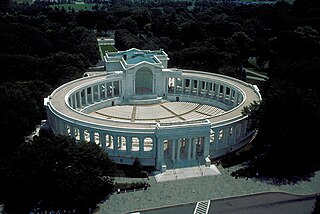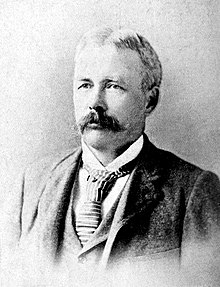
Arlington National Cemetery is one of two cemeteries in the United States National Cemetery System that are maintained by the United States Army. Nearly 400,000 people are buried in its 639 acres in Arlington, Virginia.

Arlington County is a county in the U.S. state of Virginia. The county is located in Northern Virginia on the southwestern bank of the Potomac River directly across from Washington, D.C.. The county is coextensive with the U.S. Census Bureau's census-designated place of Arlington. Arlington County is the second-largest city in the Washington metropolitan area, although it does not have the legal designation of an independent city or incorporated town under Virginia state law.

A monument is a type of structure that was explicitly created to commemorate a person or event, or which has become relevant to a social group as a part of their remembrance of historic times or cultural heritage, due to its artistic, historical, political, technical or architectural importance. Some of the first monuments were dolmens or menhirs, megalithic constructions built for religious or funerary purposes. Examples of monuments include statues, (war) memorials, historical buildings, archaeological sites, and cultural assets. If there is a public interest in its preservation, a monument can for example be listed as a UNESCO World Heritage Site.

Rosslyn is a heavily urbanized unincorporated area in Northern Virginia located in the northeastern corner of Arlington County, Virginia, north of Arlington National Cemetery and directly across the Potomac River from Georgetown and Foggy Bottom in Washington, D.C.

Volunteer Park is a 48.3-acre (19.5 ha) park in the Capitol Hill neighborhood of Seattle, Washington, United States.

Montgomery Cunningham Meigs was a career United States Army officer and civil engineer, who served as Quartermaster General of the U.S. Army during and after the American Civil War. Meigs strongly opposed secession and supported the Union. His record as Quartermaster General was regarded as outstanding, both in effectiveness and in ethical probity, and Secretary of State William H. Seward viewed Meigs' leadership and contributions as key factors in the Union victory in the war.

The George Washington Memorial Parkway, colloquially the G.W. Parkway, is a 25-mile-long (40 km) parkway that runs along the south bank of the Potomac River from Mount Vernon, Virginia, northwest to McLean, Virginia, and is maintained by the National Park Service (NPS). It is located almost entirely within Virginia, except for a short portion of the parkway northwest of the Arlington Memorial Bridge that passes over Columbia Island within the District of Columbia.

Memorial Amphitheater is an outdoor amphitheater, exhibit hall, and nonsectarian chapel located in Arlington National Cemetery in Arlington County, Virginia, in the United States. Designed in 1913 as a replacement for the older, wooden amphitheater near Arlington House, ground was broken for its construction in March 1915 and it was dedicated in May 1920. In the center of its eastern steps is the Tomb of the Unknowns, dedicated in 1921. It has served as the site for numerous Veterans Day and Memorial Day services, as well as for memorial services and funerals for many individuals.

Arlington House is the historic family residence of Robert E. Lee, commander of the Confederate Army, and a national memorial in his honor serving as a museum, located in Arlington County, Virginia. It is situated in the middle of Arlington National Cemetery, overlooking the Potomac River and the National Mall in Washington, D.C.

The Women In Military Service For America Memorial, also known as Military Women's Memorial, is a memorial established by the U.S. federal government which honors women who have served in the United States Armed Forces. The memorial is located at the western end of Memorial Avenue at the entrance to Arlington National Cemetery in Arlington County, Virginia, in the United States. The structure in which the memorial is housed was originally known as the Hemicycle, and built in 1932 to be a ceremonial entrance to the cemetery. It never served this purpose, and was in disrepair by 1986. Congress approved the memorial in 1985, and the Hemicycle approved as the site for the memorial in 1988. An open design competition was won by New York City architects Marion Weiss and Michael Manfredi. Their original design was leaked to the public, and caused significant controversy. Two years of fund-raising and design revision followed. A revised preliminary design was approved in July 1992, and the final design in March 1995. Ground was broken for the memorial in June 1995, and the structure was dedicated on October 18, 1997.

George Washington Parke Custis was an American plantation owner, antiquarian, author, and playwright. His father John Parke Custis was the stepson of George Washington. He and his sister Eleanor grew up at Mount Vernon and in the Washington presidential household.

Mary Anna Randolph Custis Lee was the wife of the Confederate general Robert E. Lee and the last private owner of Arlington Estate. She was the daughter of George Washington Parke Custis who was the grandson of Martha Dandridge Custis Washington, the wife of George Washington.

Abingdon was an 18th- and 19th-century plantation owned by the prominent Alexander, Custis, Stuart, and Hunter families and worked at times by slaves and domesticated animals. The plantation's site is now located in Arlington County in the U.S. state of Virginia.

The Civil War Unknowns Monument is a burial vault and memorial honoring unidentified dead from the American Civil War. It is located in the grounds of Arlington House, The Robert E. Lee Memorial, at Arlington National Cemetery in Arlington, Virginia, in the United States. It was designed by Quartermaster General Montgomery C. Meigs and constructed in 1865.
Arlington Ridge Road is a street through residential areas and business districts in Arlington County, Virginia in the United States. South Arlington Ridge Road is roughly 1.5 miles in length and extends from Prospect Hill Park/Army-Navy Drive in the north to Glebe Road and Four Mile Run creek in the south. As it crosses the creek it turns into Mount Vernon Avenue. Arlington Ridge Road was first constructed in 1840, and formerly extended north through Arlington National Cemetery to Rosslyn, Virginia near Francis Scott Key Bridge and the Potomac River.

The McClellan Gate is a memorial to Major General George B. McClellan located inside Arlington National Cemetery in Arlington County, Virginia, in the United States. Constructed about 1871 on Arlington Ridge Road, it served as a main gate until about 1879 when the Sheridan Gate was constructed. The McClellan Gate became nonfunctional in 1966 when the road closed, and expansion of the cemetery eastward in 1971 left the gate deep inside Arlington. It is the only gate constructed on the cemetery's eastern boundary in the 1800s that survives.

The Confederate Memorial is a memorial in Arlington National Cemetery in Arlington County, Virginia, in the United States, that commemorates members of the armed forces of the Confederate States of America who died during the American Civil War. Authorized in March 1906, former Confederate soldier and sculptor Moses Jacob Ezekiel was commissioned by the United Daughters of the Confederacy in November 1910 to design the memorial. It was unveiled by President Woodrow Wilson on June 4, 1914.

The Syphax family is a prominent American family in the Washington, D.C., area. A part of the African-American upper class, the family is descended from Charles Syphax and Mariah Carter Syphax, both born into slavery. She was the daughter of an enslaved woman and planter George Washington Parke Custis, only grandson of First Lady Martha Washington.

Selina Norris Gray was an African American woman known for saving some of George Washington's heirlooms when Union soldiers seized and occupied Arlington House, the home of Confederate Army General Robert E. Lee on May 24, 1861.


























